Effects of High Temperature and Different Salt Solutions on Basalt Fiber-Reinforced Composites’ Bonded Joint Durability Impact
Abstract
:1. Introduction
2. Materials and Methods
2.1. Materials
2.2. Preparation of Test Pieces
- (1)
- Selection of BFRP substrate. In order to ensure the area of the bonding area, the water jet is used to accurately cut the sheet, and the cut sheets are reasonably matched.
- (2)
- Numbering the test pieces. In order to avoid obtaining the wrong substrate during the bonding process, the test pieces are numbered.
- (3)
- Mark the bonding area. Mark a horizontal line at 25 cm on the BFRP substrate to ensure that the bonding area is 25 cm × 25 cm.
- (4)
- Wipe the BFRP substrate: Since the BFRP substrate will stick to grease and dust during the production process, this can seriously affect the bonding performance, meaning that the research cannot draw the most realistic conclusion. Therefore, use acetone to wipe the surface of BFRP before bonding to remove the grease and dust on the surface, and maximize the effect of the adhesive.
- (5)
- Apply glue. After wiping with acetone for 10–15 min, use glue gun to glue.
- (6)
- Carry out bonding. The whole bonding process is carried out at room temperature (25 ± 2 °C). When bonding, lap two BFRP substrates on the fixture, add gaskets to control the thickness of the adhesive layer at 0.1 mm, and finally press and tighten the joints.
2.3. Experimental Method
2.4. Water Absorption Test
2.5. DSC Test
2.6. FTIR Test
2.7. TGA-DTG Analysis
3. Results
3.1. Hygroscopicity Analysis
3.2. Adhesive DSC Results
3.3. FTIR Results
3.4. TGA-DTG Results
3.5. Tensile Test Analysis
3.5.1. Failure Strength Analysis
3.5.2. Load Displacement Curve
3.5.3. Failure Mode Analysis
4. Conclusions
- (1)
- The adhesive has a lower saturated water absorption in the salt solution. The presence of ions inhibits the entry of water into the interior of the adhesive, resulting in a higher failure strength of the bonded joint in the salt solution. This is consistent with the results obtained from the DSC test.
- (2)
- The TGA-DTG results showed that the final residual mass of the adhesive in the three environments was extremely similar, which was 22%, 23%, and 21% of the original mass, respectively. In addition, the TGA-DTG curves of the adhesive after aging for different times were very similar. The decrease in quality is due to the evaporation of water due to the increase in temperature and the degradation of some of the resins in the adhesive.
- (3)
- As the aging time increases, The concentration of the salt solution had no significant effect on the adhesive nor on the bonded joints. The Tg values of the adhesive in the two environments of the 3.5% NaCl solution and 5% NaCl solution were similar, and the failure strength curves of the bonded joints in the two environments were close to overlapping. However, the Tg decreased by 46.42% after aging for 30 days in the DW solution environment. The decrease in the adhesive’s Tg was related to the humidity-induced plasticizing effect and the decrease in the density of the cross-linked polymer.
- (4)
- The bonded joints changed from tearing failure to mixed failure mainly due to internal polymerization before and after aging, and the hydrolysis led to a decrease in the bonding performance of the adhesive, which was corroborated by the FTIR results, which showed that the high temperature decreased the moisture with the increase in the aging time and the post-curing reaction impeded the hydrolysis reaction. The change in the failure mode of the bonded joints is the result of the post-curing effect and the hydrolysis reaction.
Author Contributions
Funding
Institutional Review Board Statement
Data Availability Statement
Conflicts of Interest
References
- Elmarakbi, A. Advanced Composite Materials for Automotive Applications: Structural Integrity and Crashworthiness; John Wiley & Sons: Hoboken, NJ, USA, 2013. [Google Scholar]
- Lin, J.; Sun, C.; Min, J.; Wan, H.; Wang, S. Effect of atmospheric pressure plasma treatment on surface physicochemical properties of carbon fifiber reinforcedpolymer and its interfacial bonding strength with adhesive. Compos. Part B Eng. 2020, 199, 108237. [Google Scholar] [CrossRef]
- Vedernikov, A.; Gemi, L.; Madenci, E.; Özkılıç, Y.O.; Yazman, Ş.; Gusev, S.; Sulimov, A.; Bondareva, J.; Evlashin, S.; Konev, S.; et al. Effects of high pulling speeds on mechanical properties and morphology of pultruded GFRP composite flat laminates. Compos. Struct. 2022, 301, 116216. [Google Scholar] [CrossRef]
- Chen, W.; Hao, H.; Jong, M.; Cui, J.; Shi, Y.; Chen, L.; Pham, T.M. Quasi-static and dynamic tensile properties of basalt fibre reinforced polymer. Compos. Part B Eng. 2017, 125, 123–133. [Google Scholar] [CrossRef]
- Lopresto, V.; Leone, C.; De Iorio, I. Mechanical characterisation of basalt fibre reinforced plastic. Compos. Part B Eng. 2011, 42, 717–723. [Google Scholar] [CrossRef]
- Wang, X.; Shi, J.; Wu, Z.; Zhu, Z. Fatigue Behavior of Basalt Fiber-Reinforced Polymer Tendons for Prestressing Applications. J. Compos. Constr. 2016, 20, 04015079. [Google Scholar] [CrossRef]
- Cui, J.; Gao, S.; Jiang, H.; Huang, X.; Lu, G.; Li, G. Adhesive bond-electromagnetic rivet hybrid joining technique for CFRP/Al structure: Process, design and property. Compos. Struct. 2020, 244, 112316. [Google Scholar] [CrossRef]
- Marannano, G.; Zuccarello, B. Numerical experimental analysis of hybrid double lap aluminum-CFRP joints. Compos. Part B Eng. 2015, 71, 28–39. [Google Scholar] [CrossRef]
- Zhang, Y.; Vassilopoulos, A.P.; Keller, T. Effects of low and high temperatures on tensile behavior of adhesively-bonded GFRP joints. Compos. Struct. 2010, 92, 1631–1639. [Google Scholar] [CrossRef]
- Kaiser, I.; Tan, C.; Tan, K. Bio-inspired patterned adhesive single-lap joints for CFRP and titanium. Compos. Part B Eng. 2021, 224, 109182. [Google Scholar] [CrossRef]
- Qin, G.; Na, J.; Mu, W.; Tan, W.; Yang, J.; Ren, J. Effect of continuous high temperature exposure on the adhesive strength of epoxy adhesive, CFRP and adhesively bonded CFRP-aluminum alloy joints. Compos. Part B Eng. 2018, 154, 43–55. [Google Scholar] [CrossRef]
- Kim, G.; Ajersch, F. Surface energy and chemical characteristics of interfaces of adhesively bonded aluminium joints. J. Mater. Sci. 1994, 29, 676–681. [Google Scholar] [CrossRef]
- Machado, J.; Nunes, P.; Marques, E.; da Silva, L.F. Adhesive joints using aluminium and CFRP substrates tested at low and high temperatures under quasi-static and impact conditions for the automotive industry. Compos. Part B Eng. 2019, 158, 102–116. [Google Scholar] [CrossRef]
- Yousef, S.; Eimontas, J.; Striūgas, N.; Abdelnaby, M.A. Influence of carbon black filler on pyrolysis kinetic behaviour and TG-FTIR-GC–MS analysis of glass fibre reinforced polymer composites. Energy 2021, 233, 121167. [Google Scholar] [CrossRef]
- Huang, K.; Zheng, J.; Yuan, W.; Wang, X.; Song, Q.; Li, Y.; Crittenden, J.C.; Wang, L.; Wang, J. Microwave-assisted chemical recovery of glass fiber and epoxy resin from non-metallic components in waste printed circuit boards. Waste Manag. 2021, 124, 8–16. [Google Scholar] [CrossRef] [PubMed]
- Mazzuca, P.; Ombres, L.; Guglielmi, M.; Verre, S. Residual Mechanical Properties of PBO FRCM Composites after Elevated Temperature Exposure: Experimental and Comparative Analysis. J. Mater. Civ. Eng. 2023, 35, 04023383. [Google Scholar] [CrossRef]
- Sousa, J.; Correia, J.; Gonilha, J.; Cabral-Fonseca, S.; Firmo, J.; Keller, T. Durability of adhesively bonded joints between pultruded GFRP adherends under hygrothermal and natural ageing. Compos. Part B Eng. 2019, 158, 475–488. [Google Scholar] [CrossRef]
- Li, W.D.; Ma, M.; Han, X.; Tang, L.P.; Zhao, J.N.; Gao, E.P. Strength prediction of adhesively bonded single lap joints under salt spray environment using a cohesive zone model. J. Adhes. 2016, 92, 916–937. [Google Scholar] [CrossRef]
- Bordes, M.; Davies, P.; Cognard, J.-Y.; Sohier, L.; Sauvant-Moynot, V.; Galy, J. Prediction of long term strength of adhesively bonded steel/epoxy joints in sea water. Int. J. Adhes. Adhes. 2009, 29, 595–608. [Google Scholar] [CrossRef]
- Papanicolaou, G.; Charitidis, P.; Mouzakis, D.; Karachalios, E.; Jiga, G.; Portan, D. Experimental and numerical investigation of balanced Boron/Epoxy single lap joints subjected to salt spray aging. Int. J. Adhes. Adhes. 2016, 68, 9–18. [Google Scholar] [CrossRef]
- Anderson, B.J. Thermal stability of high temperature epoxy adhesives by thermogravimetric and adhesive strength measure-ments. Polym. Degrad. Stab. 2011, 96, 1874–1881. [Google Scholar] [CrossRef]
- Hancox, N. Thermal effects on polymer matrix composites: Part 1: Thermal cycling. Mater. Des. 1998, 19, 85–91. [Google Scholar] [CrossRef]
- Na, J.; Mu, W.; Qin, G.; Tan, W.; Pu, L. Effect of temperature on the mechanical properties of adhesively bonded basalt FRP-aluminum alloy joints in the automotive industry. Int. J. Adhes. Adhes. 2018, 85, 138–148. [Google Scholar] [CrossRef]
- Budhe, S.; Banea, M.D.; de Barros, S.; da Silva, L.F.M. An updated review of adhesively bonded joints in composite materials. Int. J. Adhes. Adhes. 2016, 72, 30–42. [Google Scholar] [CrossRef]
- Mu, W.; Qin, G.; Na, J.; Tan, W.; Liu, H.; Luan, J. Effect of alternating load on the residual strength of environmentally aged adhesively bonded CFRP-aluminum alloy joints. Compos. Part B Eng. 2019, 168, 87–97. [Google Scholar] [CrossRef]
- Doyle, G.; Pethrick, R.A. Environmental effects on the ageing of epoxy adhesive joints. Int. J. Adhes. Adhes. 2009, 29, 77–90. [Google Scholar] [CrossRef]
- Hirulkar, N.S.; Jaiswal, P.R.; Reis, P.N.B.; Ferreira, J.A.M. Effect of hygrothermal aging and cyclic thermal shocks on the mechanical per-formance of single-lap adhesive joints. Int. J. Adhes. Adhes. 2020, 99, 102584. [Google Scholar] [CrossRef]
- ISO P. 527-2; Plastics—Determination of Tensile Properties—Part 2: Test Conditions for Moulding and Extrusion Plastics. Organization of Standardization: Geneva, Switzerland, 2012.
- ASTM D570-98; ASTM Committee D-20 on Plastics. Subcommittee D20. 50 on Permanence Properties. Standard Test Method for Water Absorption of Plastics. American Society for Testing and Materials: Philadelphia, PA, USA, 1995.
- Jianze, L.; Jingxin, N.; Wei, T.; Wenlong, M.; Guangbin, W.; Yuan, G. Comparative study on mechanical properties of aluminum alloy and BFRP single lap joints with hygrothermal aging. J. Adhes. 2021, 97, 918–935. [Google Scholar] [CrossRef]
- Mourad, A.-H.I.; Idrisi, A.H.; Wrage, M.C.; Abdel-Magid, B.M. Long-term durability of thermoset composites in seawater environment. Compos. Part B Eng. 2019, 168, 243–253. [Google Scholar] [CrossRef]
- Li, H.; Zhang, K.; Fan, X.; Cheng, H.; Xu, G.; Suo, H. Effect of seawater ageing with different temperatures and concentrations on static/dynamic mechanical properties of carbon fiber reinforced polymer composites. Compos. Part B Eng. 2019, 173, 106910. [Google Scholar] [CrossRef]
- Han, X.; Pickering, E.; Bo, A.; Gu, Y. Characterisation on the hygrothermal degradation in the mechanical property of structural adhesive: A novel meso-scale approach. Compos. Part B Eng. 2020, 182, 107609. [Google Scholar] [CrossRef]
- González, M.G.; Cabanelas, J.C.; Baselga, J. Applications of FTIR on epoxy resins-identification, monitoring the curing process, phase separation and water uptake. Infrared Spectrosc.-Mater. Sci. Eng. Technol. 2012, 2, 261–284. [Google Scholar]
- Cassidy, P.E.; Johnson, J.M.; Locke, C.E. The relationship of glass transition temperature to adhesive strength. J. Adhes. 1972, 4, 183–191. [Google Scholar] [CrossRef]
- Lin, Y.; Chen, X.; Zhang, H.; Wang, Z. Effects of hygrothermal aging on epoxy-based anisotropic conductive film. Mater. Lett. 2006, 60, 2958–2963. [Google Scholar] [CrossRef]
- Xiao, G.Z.; Shanahan, M.E.R. Irreversible effects of hygrothermal aging on DGEBA/DDA epoxy resin. J. Appl. Polym. Sci. 1998, 69, 363–369. [Google Scholar] [CrossRef]
- Chen, H.; Na, J.; Wang, D.; Kong, D.; Zhang, X. Numerical simulation and failure experiment of hygrothermal aged CFRP single and double lap joints. Thin-Walled Struct. 2023, 188, 110786. [Google Scholar] [CrossRef]
- Jiao, L.; Xiao, H.; Wang, Q.; Sun, J. Thermal degradation characteristics of rigid polyurethane foam and the volatile products analysis with TG-FTIR-MS. Polym. Degrad. Stab. 2013, 98, 2687–2696. [Google Scholar] [CrossRef]
- Vijay, P.V.; Soti, P.R.; GangaRao, H.V.; Lampo, R.G.; Clarkson, J.D. Design and evaluation of an integrated FRP composite wicket gate. Compos. Struct. 2016, 145, 149–161. [Google Scholar] [CrossRef]
- Wang, S.; Wang, S.; Li, G.; Cui, J. Dynamic response and fracture analysis of basalt fiber reinforced plastics and aluminum alloys adhesive joints. Compos. Struct. 2021, 268, 114013. [Google Scholar] [CrossRef]
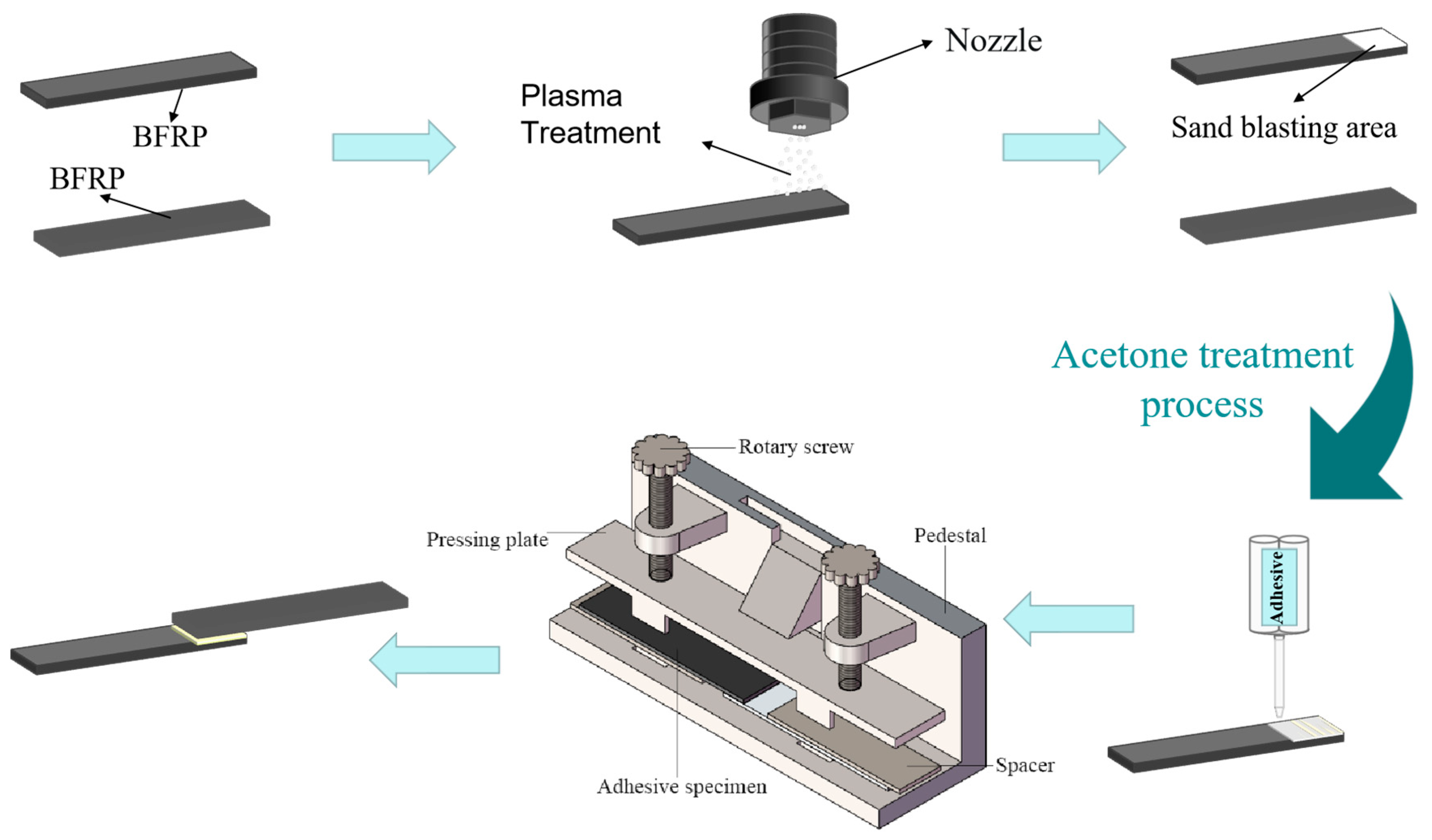
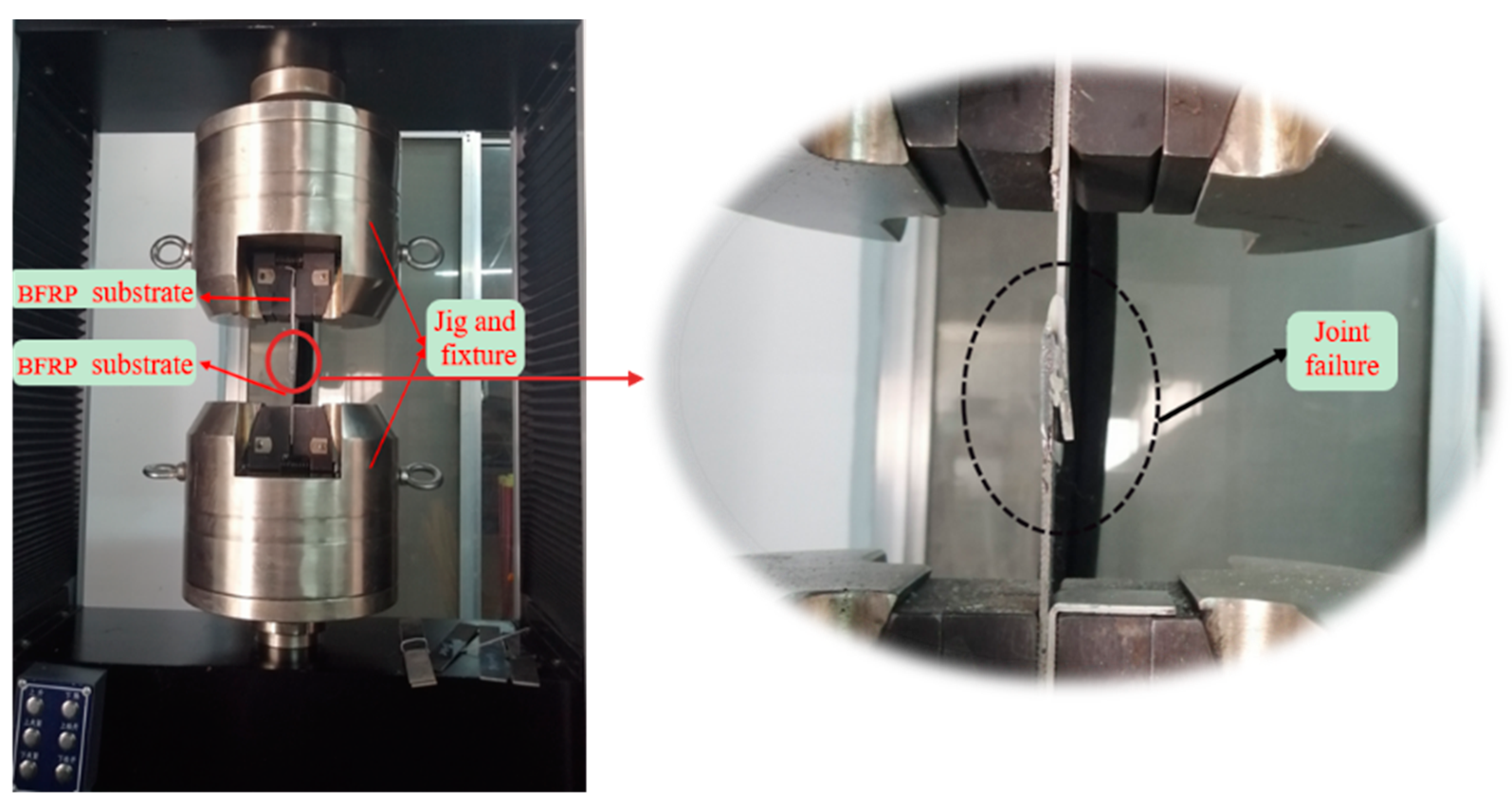
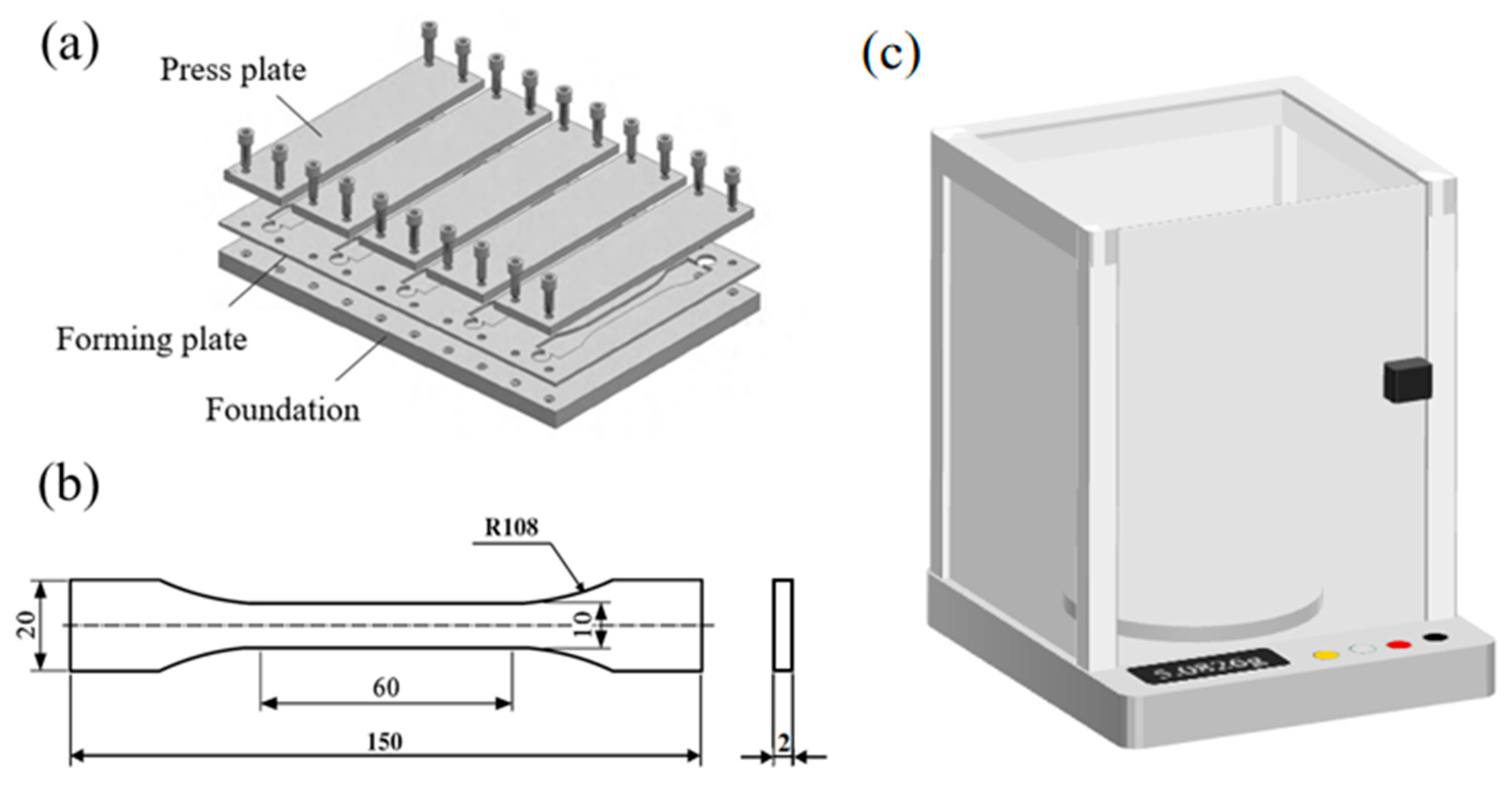
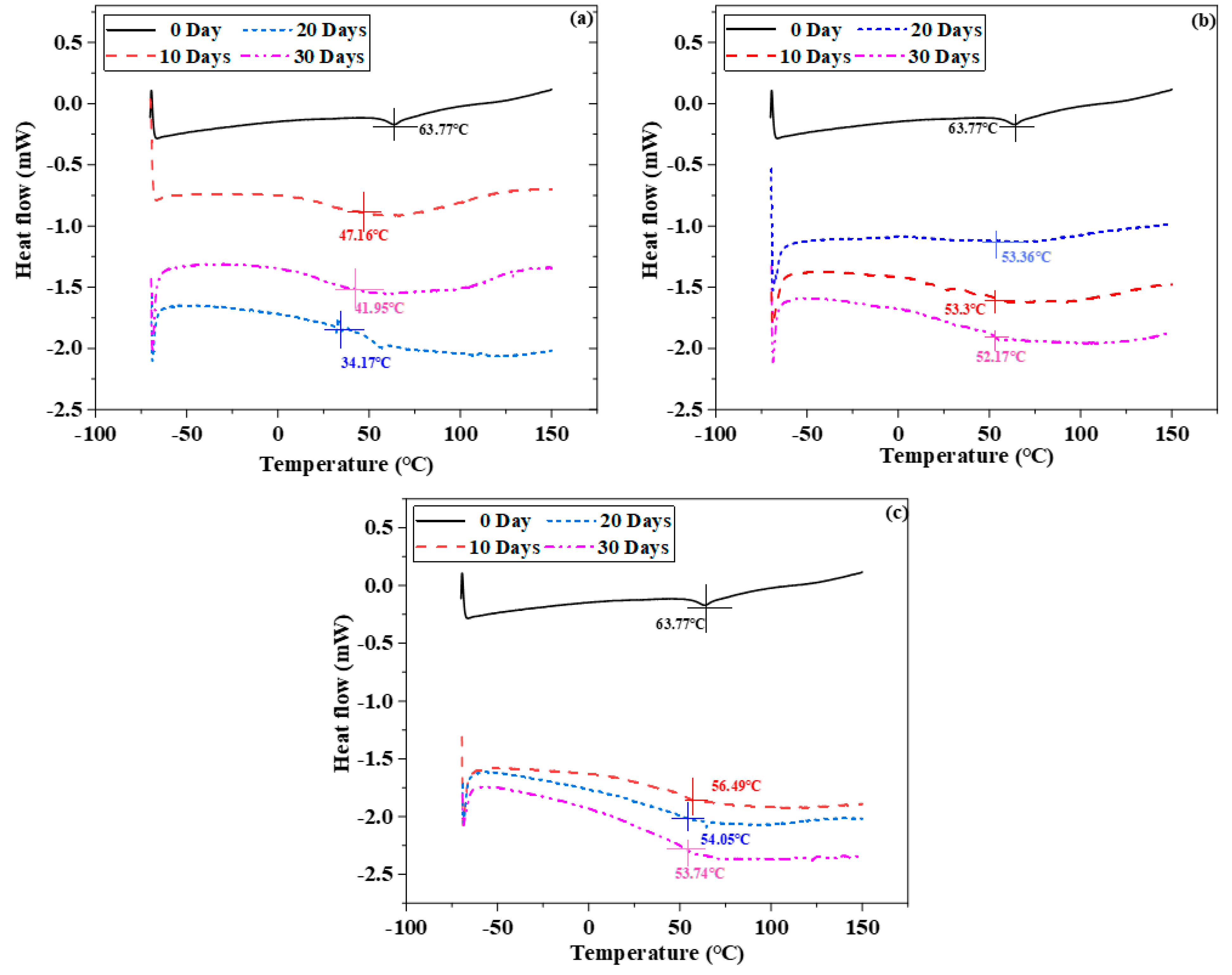
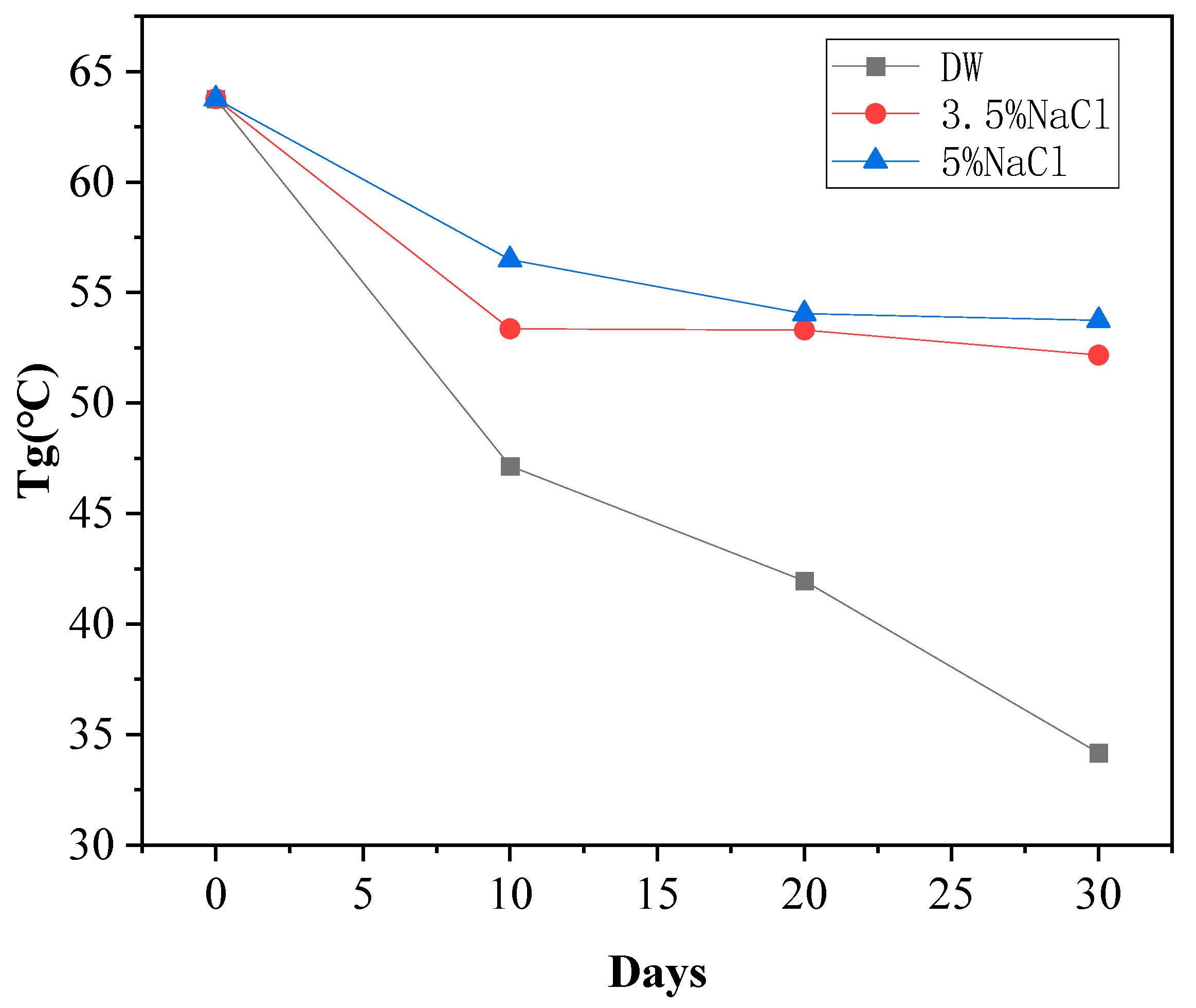
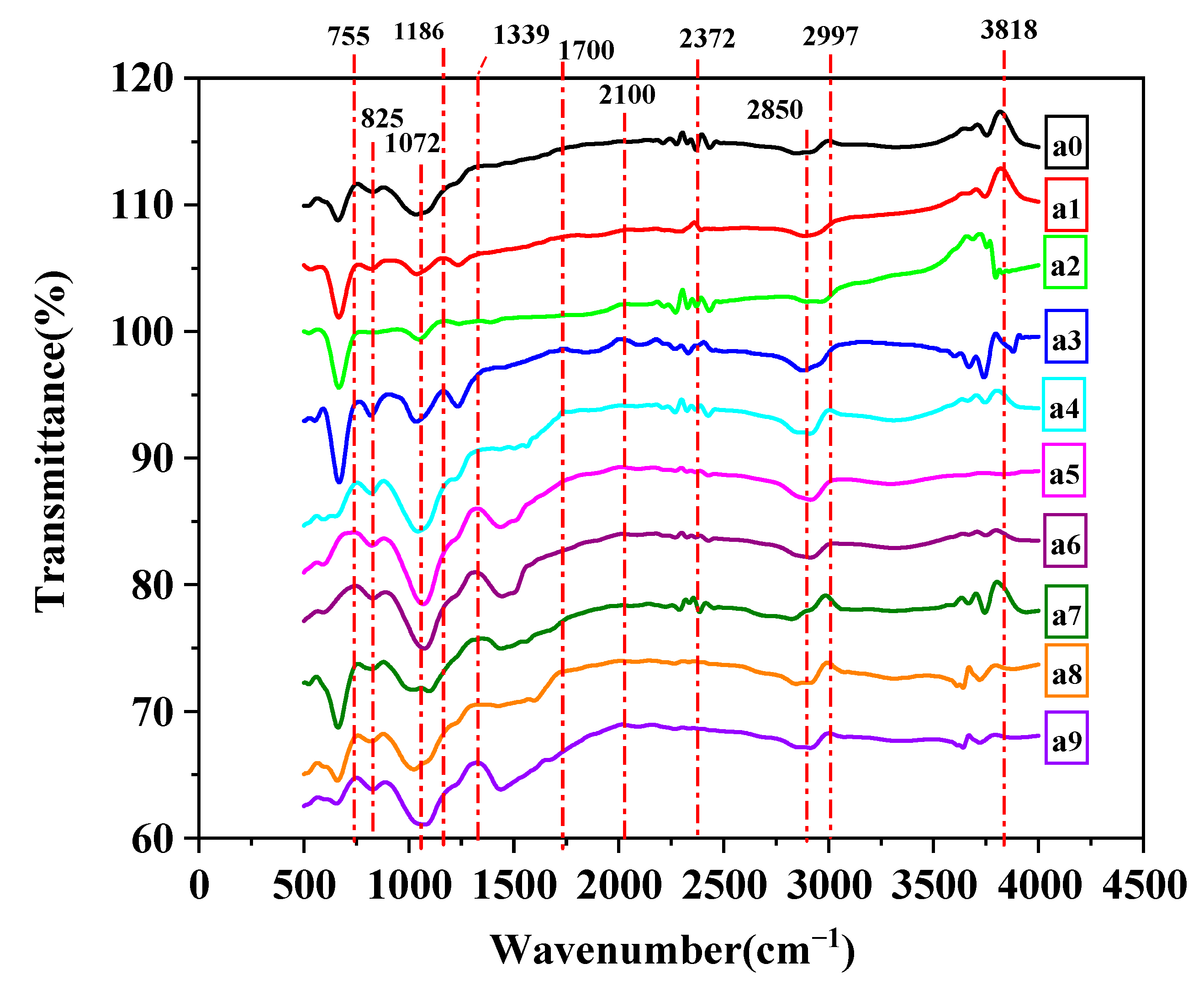

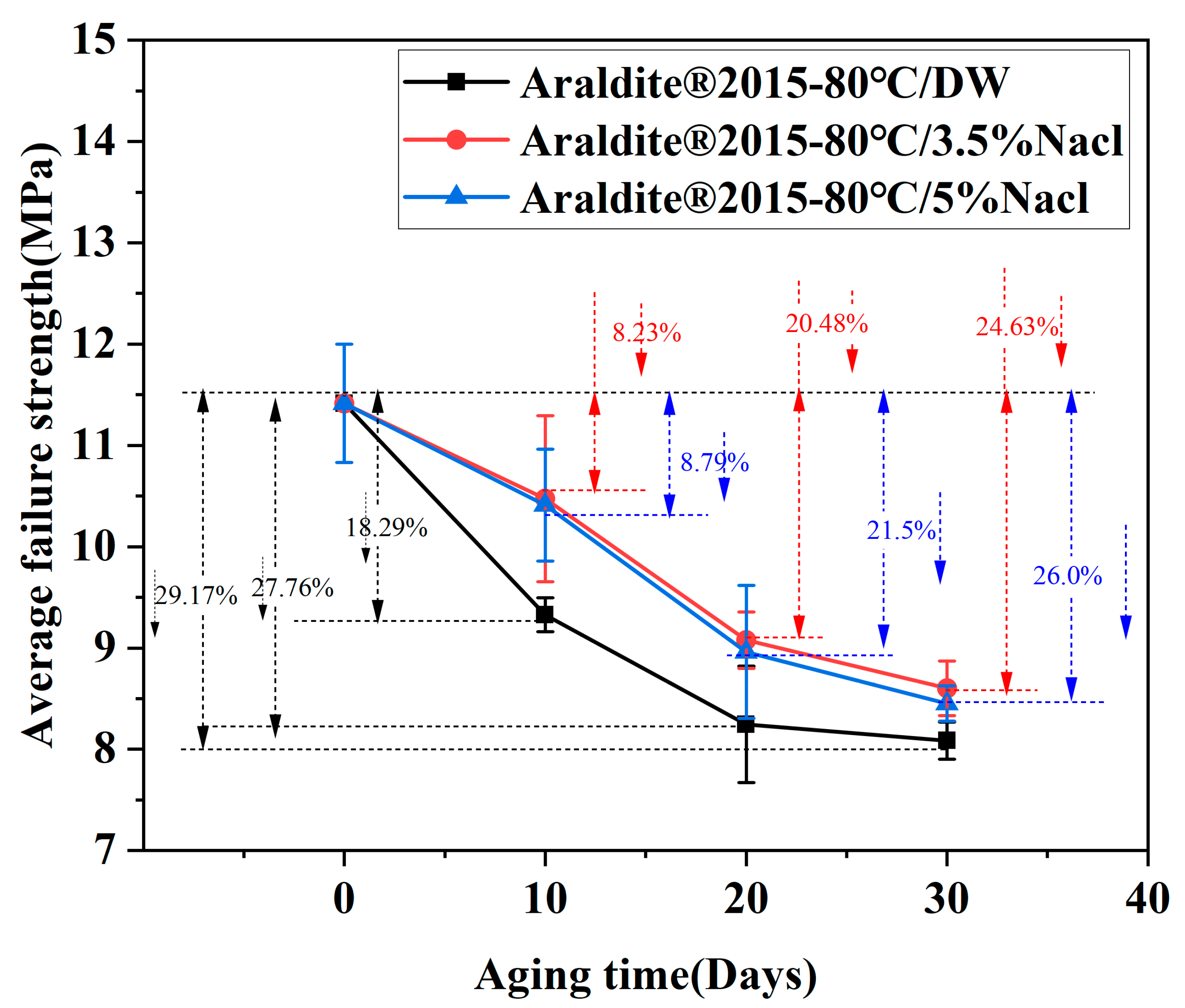

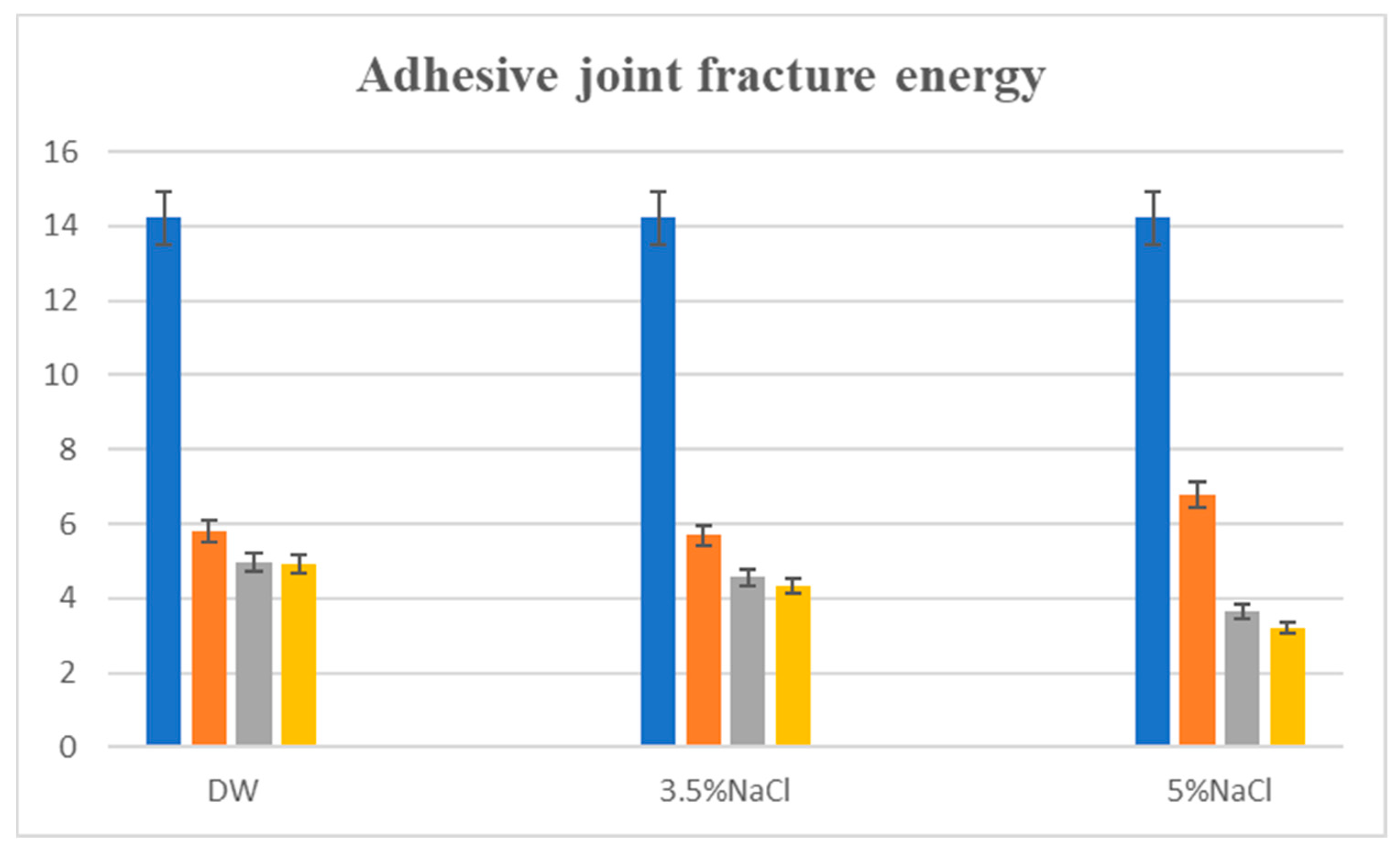
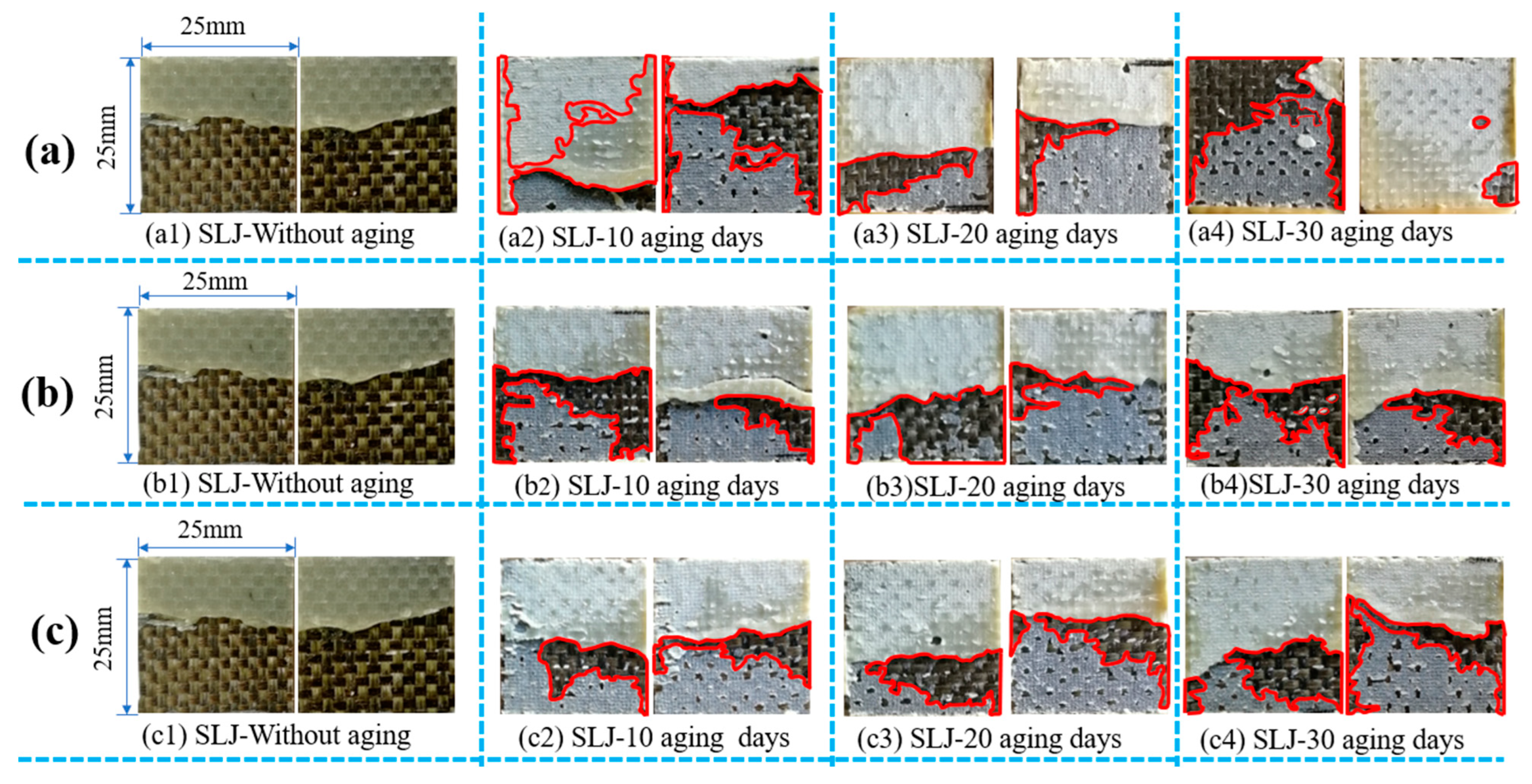
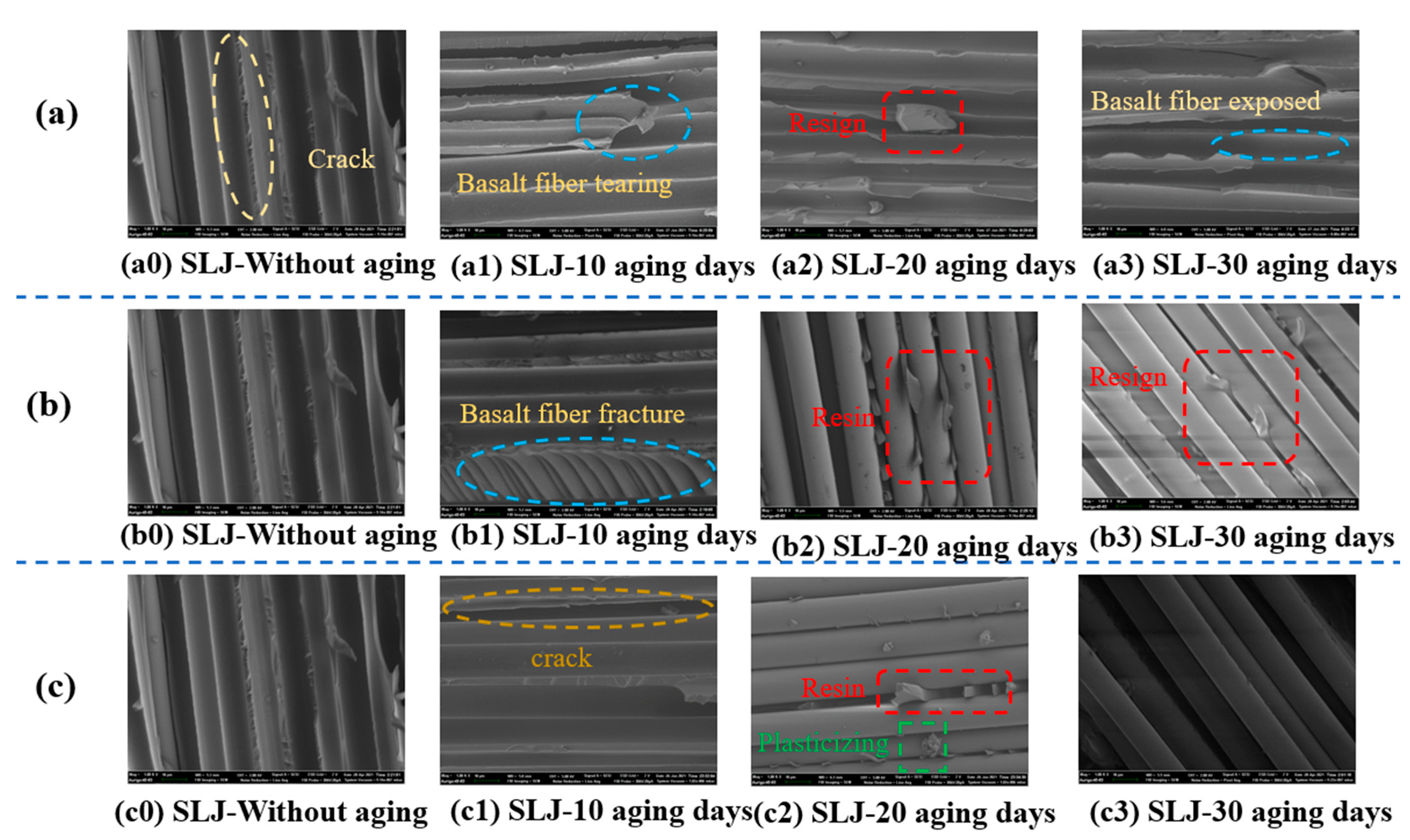
| ML-5417A/ML-5417B Epoxy Resin | Basalt Fiber Unidirectional Fabric | ||
|---|---|---|---|
| Cure condition | 25 °C × 24 h + 100 °C × 3 h | Surface density/(g·cm−2) | 300 |
| Epoxy value/(g/ep) | 165–175 | Tensile strength/(MPa) | 2100 |
| 25° Density/(g·cm−3) | 1.10–1.20 | Young’s modulus/(GPa) | 105 |
| Tensile modulus/(MPa) | 2800–3200 | Elongation/(%) | 2.6 |
| Tg/(°C) | 110–125 | Nominal thickness/(mm) | 0.115 |
| Single fiber size/(um) | 13 | ||
| Glass Transition Temperature (°C) | Young’s Modulus/GPa | Shear Modulus/GPa | Poisson’s Ratio | Density/(Kg/m3) |
|---|---|---|---|---|
| 75 ± 4 | 1.85 | 0.56 | 0.33 | 1.4 |
| Environment | Diffusion Coefficient D (10−3) | Saturated Water Absorption (%) | |
|---|---|---|---|
| Araldite®2015 | DW | 3.53 | 15.61 |
| 3.5% NaCl | 3.74 | 11.40 | |
| 5% NaCl | 3.94 | 10.32 | |
| BFRP | DW | 1.26 | 2.24 |
| 3.5% NaCl | 2.89 | 1.22 | |
| 5% NaCl | 2.95 | 1.59 |
| Wave Number (cm−1) | Functional Group |
|---|---|
| 885 cm−1 | -CH |
| 1186 cm−1 | Si-O-Si |
| 1552 cm−1 | Benzene ring |
| 1745 cm−1 | -C=O |
| 3015 cm−1 | -CH2 |
| 3801 cm−1 | O-H, N-H |
Disclaimer/Publisher’s Note: The statements, opinions and data contained in all publications are solely those of the individual author(s) and contributor(s) and not of MDPI and/or the editor(s). MDPI and/or the editor(s) disclaim responsibility for any injury to people or property resulting from any ideas, methods, instructions or products referred to in the content. |
© 2023 by the authors. Licensee MDPI, Basel, Switzerland. This article is an open access article distributed under the terms and conditions of the Creative Commons Attribution (CC BY) license (https://creativecommons.org/licenses/by/4.0/).
Share and Cite
Peng, H.; Lin, Y.; Chen, Z.; Ma, S.; Shangguan, L.; Cheng, R.; Fan, Y. Effects of High Temperature and Different Salt Solutions on Basalt Fiber-Reinforced Composites’ Bonded Joint Durability Impact. Coatings 2023, 13, 1936. https://doi.org/10.3390/coatings13111936
Peng H, Lin Y, Chen Z, Ma S, Shangguan L, Cheng R, Fan Y. Effects of High Temperature and Different Salt Solutions on Basalt Fiber-Reinforced Composites’ Bonded Joint Durability Impact. Coatings. 2023; 13(11):1936. https://doi.org/10.3390/coatings13111936
Chicago/Turabian StylePeng, Han, Yinghao Lin, Zeshao Chen, Shengtao Ma, Linjian Shangguan, Ruixue Cheng, and Yisa Fan. 2023. "Effects of High Temperature and Different Salt Solutions on Basalt Fiber-Reinforced Composites’ Bonded Joint Durability Impact" Coatings 13, no. 11: 1936. https://doi.org/10.3390/coatings13111936
APA StylePeng, H., Lin, Y., Chen, Z., Ma, S., Shangguan, L., Cheng, R., & Fan, Y. (2023). Effects of High Temperature and Different Salt Solutions on Basalt Fiber-Reinforced Composites’ Bonded Joint Durability Impact. Coatings, 13(11), 1936. https://doi.org/10.3390/coatings13111936







